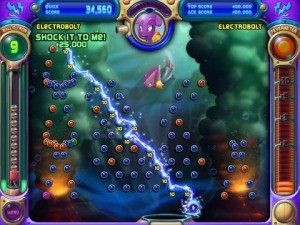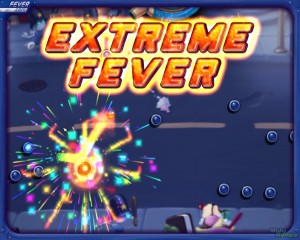Whoa! Bet you didn’t expect a PopCap casual game to crack the top fifty, did you?
But here it is. And frankly, it deserves it. Three times I’ve gotten sucked into Peggle, become totally obsessed, and emerged about a week later wondering if I’m what’s wrong with America.
Can you really blame me, though? Peggle (along with its expansion, Peggle Nights) might be the best designed game of all time, and I don’t mean that facetiously. It’s carefully and precisely engineered to bring the maximum amount of satisfaction with the minimum amount of effort and still make you feel like you’re in control of what’s happening.
In other words, it’s “the gaming equivalent of premium crack cocaine.”
So let’s break down each of Peggle’s brilliant, evil mastermind design choices, and how they encourage a “just one more peg” mindset that rapidly turns into “can I have my humanity back?” addiction.
- The name
“Aww, Peggle,” you think. “That’s a cute name. Sounds like some harmless fun. Maybe I’ll try it for a few minutes.”
Six hours later, you realize you skipped lunch AND dinner.
- The basic game mechanics
Peggle has gameplay just complex enough to keep you interested.
Every level looks something like a pinball machine — or, more accurately, a pachinko board — with about a hundred pegs. Twenty five of those pegs are orange. You ten chances to launch a pinball-style ball onto the board. With those ten balls, you have to light up all twenty five pegs to beat the level.
Once each ball falls to the bottom of the level, any pegs that have lit up disappear. If you earned enough points or landed the ball in the moving bucket at the bottom of the board, you get an “extra ball” to clear the orange pegs.
It’s so simple and satisfying to watch a pinball bounce from peg to peg, hoping it hits a bunch of them, specifically the orange ones. It’s just plain fun and enjoyable on a very basic level.
- The simplicity
A level of Peggle takes a little less than five minutes to play. It takes all of about fifteen seconds to learn.
So that makes it an ideal game to play on a smart phone while you’re waiting in line or sitting the Metro or something. It runs in short, sweet bursts.
- The luck-vs.-skill dichotomy
Of course, there’s a lot happening right underneath the surface that makes it fun. The design makes you feel in control — there are no dice or random numbers to determine how good your shot is, it’s just bouncing and physics. Yet it’s also basically impossible to predict more than a few pegs exactly where the ball will go, so the truth is that it’s quite a bit of luck.
If the game was truly masterable, it would be less addictive. There’s a certain unconquerable element of the game that keeps it challenging and fun, yet it all feels manageable and real enough that you WANT to master it.
And anyone who tells you that there’s “no skill whatsoever” involved when playing Peggle has clearly never set up and executed a perfect double Spooky Ball. There’s enough skill involved to allow you to plan and strategize, and little enough skill required that you can play and shut your brain off if you want to. THAT is the key to this game.
- The sparkly colors and lights
Things light up! There’s lots of blue and green and purple and saturated, pretty, sparkly colors. It’s fun to look at. It satisfies your urge for sensory stimulation as you stare at whatever screen it is you’re playing the game on.
If you win the level, fireworks go off and the screen says “EXTREME FEVER” in huge letters. It makes you feel like a champion.
The simple, colorful, bright palette is a contrast to the gritty design that dominates modern gaming. This is cheesy and cutesy, but never in an annoying way. Throw in some pop culture pastiches and you have a visually charming game.
- The power ups
The spice to the gameplay is the variety of the power ups.
From the dull Bjorn power up — target your ball a little bit more accurately — to the devastating fireball of Lord Cinderbottom, there are ten powerups of ranging usefulness and thrilling feelings of power.
My favorite has to be the Spooky Ball, which regenerates the ball at the top after falls to the bottom. This allows you to rack up obscene combos, sometimes knocking out what feels like half the board in one launch.
- The sounds
And here is the the pièce de résistance of Peggle: the use of sound to give you intense satisfaction as you play this dumbass game.
It starts very simply, with the sound when you hit a peg. It’s a tone that becomes higher and higher pitched as you hit more and more pegs. That alone makes you feel fulfilled as you pull off badass combos.
The rare times that you land an ultimate move of 75k points or more, you get a harmonious, angelic chime each time your ball hits a pegs. It confirms what you already knew at that point, that you’ve ascended above mere mortality thanks to your killer Peggle skills.
Best of all is the victory sound once you hit the 25th orange peg. Your speakers echo with the final verse of “Ode to Joy,” euphoric and ridiculous in the best way. This is one of the iconic elements of Peggle. The game zooms in on the ball, which starts moving in slow motion. You aren’t just a winner, you aren’t just a victor: You are a deity, and Peggle is your dominion.
- The variety
There’s just enough variety in Peggle’s game modes to prevent you from getting bored. There are about fifty different challenges that range from getting a high score to beating multiple levels in a row to accomplishing some unusual feat.
There are also “duel” modes in which you play against a friend or a computer to try and rack up the most points with just five balls.
And, of course, there’s the simple “quick play” mode that allows you to play every level, try and achieve a top score, and try and clear all one hundred pegs (which is MUCH harder than just clearing the orange pegs).
It adds up to a pleasant little mix of ways to ways to waste your time playing Peggle.
- The challenge
Peggle has some pretty hardcore challenges for you to tackle.
The grand master challenge, in my mind, is the 750k challenge: Get 750,000 points in any level of your choice. It’s insanely difficult, requires a lot of skill and even more luck, and makes you feel like David Tyree with the helmet catch when you pull it off. WHICH I HAVE. Bow before me.
I pulled it off with an incredible double Spooky Ball — plus a bunch of lucky bounces — on the Das Bucket stage from the first world, which makes it about as easy as possible to get an absurdly high-scoring move.I haven’t conquered every Peggle-related peak there is to climb. Hundred percenting all the levels and winning the ten-level challenge are still beyond the scope of my accomplishments. Maybe I’ll get there someday. (Lord knows I’ll try.)
But seriously, I beat the 750k challenge (and without any of the pure-luck or busted-game gimmicks the internet recommends). Play for a few hours and tell me this is not an impressive feat.
- In summary
Peggle coalesces into an addictive, brilliant, absurdly fun game that keeps me coming back on the iPhone and the computer more than most “real” games do. It’s a goddamn masterpiece in my book, and I bear no shame ranking it so high in my Top 100 Everything.







![Spoooookyball [waggles fingers]](http://earnthis.net/wp-content/uploads/2014/03/peggle-spooky1-300x225.jpg)


Not to “take you down a peg” (heheheheheh), but Peggle didn’t hold my interest for very long. I didn’t feel “in control” enough. But the spooky ball was definitely my favorite powerup, so we’re in agreement there.
However, I am TOTALLY behind a PopCap game being named a high-ranking “best thing.” I’m of the opinion that “casual” is a matter of lifestyle, not game design, and I frequently find myself demonstrating “hardcore” devotion to Popcap’s titles. Some of my favorites have been Seven Seas (a grid-based naval combat game), Zuma (colorful, fast-paced, frog-themed action), and the best of all, Rocket Mania (I made it all the way to “Elemental Sage” in the rankings).